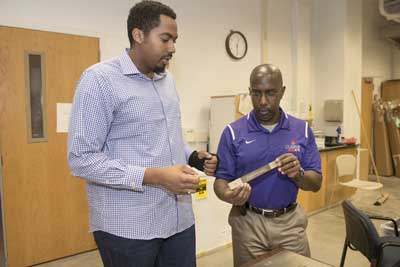| Posted: Dec 13, 2017 |
Vehicles could get 'nerves' that sense damage with new research
(Nanowerk News) Helicopters, tanks and other vehicles could someday be made of "smart material" that senses damage, similar to how nerves tell the body it has been injured, with the help of new research based at Clemson University and funded by the U.S. Army Research Laboratory.
|
|
The idea is that magnetically sensitive material would be embedded within the smart material throughout the vehicle and act as a sensor that says, "Ouch! We have damage here," said Oliver Myers, an associate professor of mechanical engineering.
|
|
Just as pain is relayed to the brain, the damage report would go to a computer and help determine whether a vehicle should keep going or return to the depot.
|
|
"In the field, we need that self-diagnostic capability," Myers said. "Lieutenant Data in 'Star Trek' always says, 'I'm performing to specified parameters.' We want to make sure our platforms are performing to those specified parameters at a minimum."
|
|
Myers is receiving $993,492 from the U.S. Army Research Laboratory to lead the project.
|
 |
| Oliver Myers (right) and mechanical engineering master's student Brandon Williams work with some of the smart material they are developing at Clemson University. (Image: Clemson University)
|
|
The research could help the Army save money on rotorcraft maintenance, said Asha Hall, the lead co-principal investigator and Prognostics and Diagnostics Acting Team Lead within the Mechanics Division of the Vehicle Technology Directorate at the U.S. Army Research Laboratory.
|
|
As a safety measure, the Army replaces some parts based on how long they have been in service, whether they appear damaged or not, she said. Embedded sensors could make it possible for parts to remain in service longer, based on their condition, Hall said.
|
|
"We're trying to extend that maintenance-free operating period," she said. "The big, big impact is to reduce sustainment costs for the Army."
|
|
The research builds on the fast-growing field of composite materials, which are used in a variety of products from cars to airplanes. Composite materials often look and feel like plastic but are lighter and stronger than metals, including steel.
|
|
The team is sandwiching "magnetostrictive" material between multiple layers of composite materials, creating a laminate. The magnetostrictive material responds to a magnetic field or a change in stress, allowing it to act as the nerve that senses the damage.
|
|
"The composite laminate effectively becomes a smart structure," Myers said.
|
|
The types of damage it could detect include impacts, cracking and unusual loading, he said.
|
|
Part of what makes the team's approach unique is that the magnetostrictive material that senses the damage is embedded in the structure itself during the fabrication process, rather than attaching sensors after the structure is already built. Those external sensors often require additional equipment, Myers said.
|
|
The magnetostrictive material requires no power, is lightweight and operates in harsh environments, he said.
|
|
Richard Figliola, acting chair of the Department of Mechanical Engineering, said that Myers was well qualified to lead the research.
|
|
"Dr. Myers has deep experience in smart materials and smart structure mechanics of systems ranging from nano- to macro-scales sizes," Figliola said. "He has written journal articles and attended conferences to develop relationships with his collaborators. The award is well deserved."
|
|
Myers said the research was inspired by his master's work in the Mechanical Engineering Department at the University of Maryland, Baltimore County, where he studied under the Meyerhoff Scholarship Program. That's when he began playing with the idea of embedding materials in composite structures to see if damage could be detected.
|
|
At the time, he did it on a small scale.
|
|
Deployment to the field could be 10-20 years away, but Myers aims to move the research in that direction.
|
|
The central question Myers is asking is how the team can create a "robust sensing operation" using the embedded magnetostrictive material. Robust would mean it is observable, repeatable, measurable and sustainable, he said.
|
|
"We want this to not only be a benchtop experiment, but we want to be able to put it on larger structures and larger systems so that once we go from the benchtop coupon level we go to a full-size system and have it function as an NDE, or nondestructive evaluation, structural health-monitoring platform," he said.
|
|
Anand Gramopadhye, dean of the College of Engineering, Computing and Applied Sciences, congratulated Myers on the award.
|
|
"His cutting-edge, innovative research could produce discoveries that have a significant impact on operational capabilities and technologies for the Army," Gramopadhye said. "The amount of the award is a testament to his hard work, the creativity of his approach and his leadership in creating smart materials."
|

